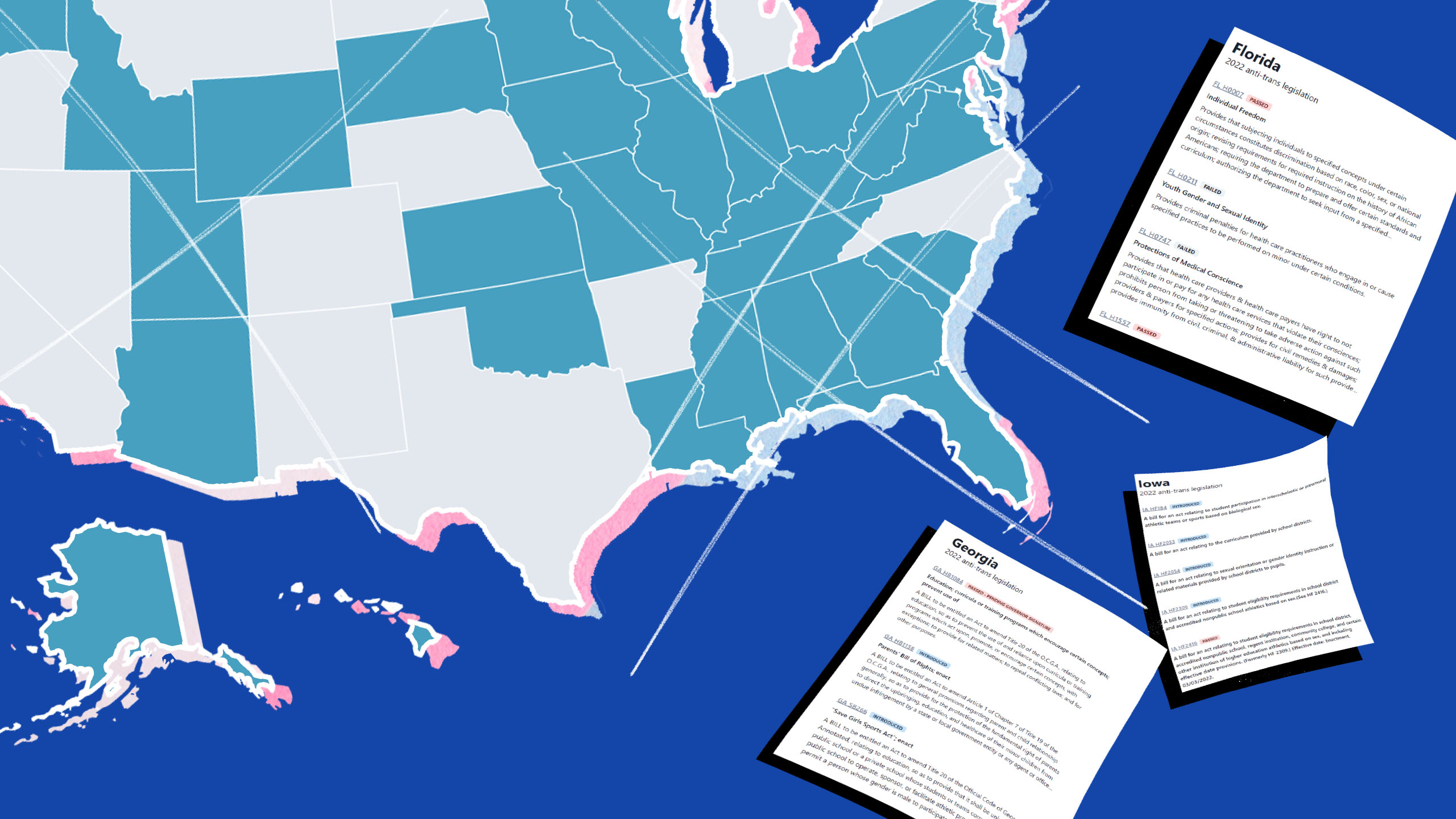The year 2021 was a record-breaking one for anti-trans legislation in the United States. Across the country, 37 states introduced 144 bills, and 18 became law. And in the first four months of 2022, more than 160 proposals targeting trans Americans have been introduced, indicating yet another historically bad year ahead.
In the midst of this ongoing battle, software developer and creative technologist Andrew Bales took action by creating Trans Legislation Tracker: a data visualization tool that aims to detail the ongoing crisis the U.S. trans community faces. Instead of merely compiling a list of discriminatory legislation, Bales created a colour-coded map using data sourced from the pro-LGBTQ2S+ advocacy groups American Civil Liberties Union (ACLU), the Human Rights Campaign (HRC), Freedom for All Americans (FFAA), plus other organizations.
Importantly, Trans Legislation Tracker isn’t simply an infographic. There is also a detailed explanation of every single piece of legislation, along with a list of each bill’s sponsors and updated information on how close it is to passage. For instance, South Dakota has introduced three anti-trans bills this year, one of which was signed into law: a sports ban claiming to protect “fairness in women’s sports.”
The project is not Bales’s first time tracking legislation: last year, they also created Inflection Point, a similar data project focused on last year’s then-unprecedented wave of discriminatory bills. They hope these tools are a visual marker for just how dire the situation is in the U.S. right now.
“I wanted to really understand the scale of it, so I started by just looking at a few individual bills.” Bales says. “The language is very brutal and direct and dehumanizing.”
In 2022, 165+ anti-trans bills were proposed in 33 states. 15 already passed. As bad as that sounds, it’s probably worse than you think. I created a legislation tracker to better understand what’s going on. I’d like to share a few things I’ve learned 🧵 https://t.co/GPLFTBDxZ1
— agbales (@agbales) April 19, 2022
For trans Americans experiencing the consequences of these bills first-hand, data visualization helps to validate their experience, and proves that they’re not alone. That can be especially important for LGBTQ2S+ youth, according to Logan Casey, senior policy researcher and advisor for the Movement Advancement Project (MAP).
“Data can show how these real-life stories are not isolated events, but rather part of a broader pattern of harm—and a pattern that policymakers have the power to change,” Casey says. “Too often, lawmakers mistakenly believe that anti-LGBTQ discrimination doesn’t happen in their district, or that discriminatory laws are acceptable if there’s no evidence that they cause harm. Data helps us prove those claims to be the falsehoods they are, and to advocate for our own needs.”
Inflection Point, in particular, was an exercise in advocacy. Alongside the interactive map, Bales also wrote an essay that contextualizes the data with help from experts like Heron Greenesmith and Chase Strangio. Using the Supreme Court’s 2015 marriage equality ruling in Obergefell v. Hodges as a starting point, Bales’s essay connects the dots between that landmark decision and our current political moment.
“What I’m laying out with this project is the direct correlation between same-sex marriage rolling into trans rights,” they say. “This is not a coincidence of cultural tides. It’s the same groups; the same people. They led this fight.”
After Obergefell, right-wing lobby organizations like the American Family Association (AFA) and Family Research Council (FRC), which have been categorized as hate groups by the Southern Poverty Law Center (SPLC), continued their fight to restrict LGBTQ2S+ equality. But this time, Bales says they focused on a new target: trans rights. Beginning with a wave of anti-trans bathroom bills in 2016, legislation pushed by these groups have sought to limit the ability of trans people to move freely and safely through society.
In seeking to roll back trans equality, many bills introduced in the past year rely on vague, unspecific language. Many do not even mention the word “trans,” according to a 2021 investigation from the progressive news site The 19th. That’s precisely why critics say they are so insidious: The lack of specificity makes it difficult to understand when or how the legislation would be enforced—or challenged.
“I could sit here all day and say that these policies are not data-driven; they’re not grounded in scientific reality.”
For example, an anti-trans bill introduced in South Dakota last year, known as House Bill 1005, says students may only use the locker room corresponding to the “person’s genetics and anatomy.” Another 2021 bill tracked by Inflection Point, Alabama’s HB 391, bans trans youth from playing on sports teams consistent with their gender identity. The latter bill, which was signed into law last April, employs the phrase “biological gender,” while failing to offer any definition of the term.
The vagueness of these proposals mask the fact that they are not scientifically sound, according to Harry Barbee, a postdoctoral researcher in the Center for Medicine, Health, and Society at Vanderbilt University.
“I could sit here all day and say that these policies are not data-driven; they’re not grounded in scientific reality,” they tell Xtra. “But the folks who are pushing these kinds of policies, they’re probably already aware of that because they’re not citing legitimate research. It’s really easy for them to marshall stereotypes and misinformation about [trans people] in order to achieve a political agenda.”
Data visualization efforts like Inflection Point and Trans Legislation Tracker can help to make sense of legislation that is often intentionally murky. But it’s difficult for the human mind to translate large-scale data into something they can actually make a difference about, says Casey.
“Good data visualization can help communicate patterns and key findings without complicated jargon or obstacles to understanding,” he says. “But data is not a quick fix or easy solution, especially in an age of misinformation. We’ve seen good, rigorous research intentionally misinterpreted to advance anti-LGBTQ beliefs, and we’ve seen discredited, dangerous ideas dressed up to look like data for the same purpose, to undermine LGBTQ equity.”
No data tool is perfect, and Bales recognizes that it’s “exhausting” to try and capture the public’s attention in an era of information overload. But they hope that the resources they’ve amassed will be a starting point for a much larger conversation about the toll these attacks are taking on the U.S. trans community.
“I don’t know if I’m just more of a pessimist, but it feels like: What’s the point? Why does my voice matter?” Bales says they often worry. “But for me, I’ll be happy if people walk away more culturally engaged and ready to go and learn more about it.”


 Why you can trust Xtra
Why you can trust Xtra


